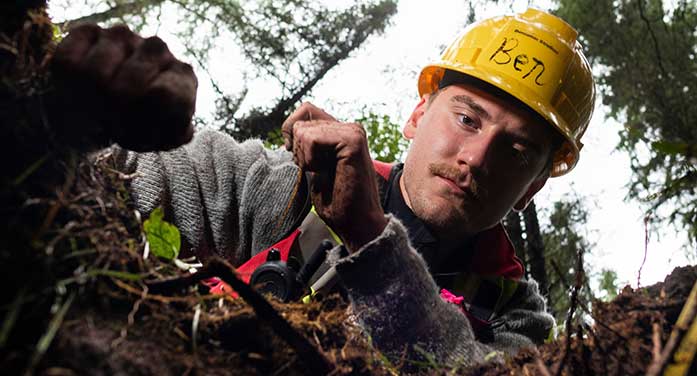By the time Ben Strelkov started high school, the self-described “city kid” assumed that once he was in the workforce, he’d be confined to an office, doing basically the same thing every workday.
His summer job following Grade 10 shattered the illusion.
“I spent the whole time in northern Alberta – building trails, helping communities protect themselves from forest fires. It was a blast,” said Strelkov, recalling the two summers he worked with Alberta’s Junior Forest Ranger program.
Strelkov’s decision to join the University of Alberta’s forestry program after high school graduation is bound to be music to the ears of Alberta’s forest industry. According to the Alberta Forest Products Association, the sector creates jobs for more than 40,000 people in the province, directly or indirectly. But more than a quarter of those working directly in the industry are within 10 years of retirement age – well above the provincial average. Alberta needs thousands of foresters in the next decade.

Students in forestry and environmental and conservation sciences recently attended the annual field school offered by the Faculty of Agricultural, Life & Environmental Sciences. The school was reconfigured with pandemic safety and lower fees for students in mind, but still teaches students skills that are vital for their future careers. (Photo: John Ulan)
“There are tons of opportunities,” Strelkov said cheerfully one day recently while deep in a forest west of Edmonton. He was taking part in the annual field school offered by the Faculty of Agricultural, Life & Environmental Sciences for students in forestry and environmental and conservation sciences.
Students learn how to measure trees, navigate with a GPS, collect and identify various types of soil and plants, and many other skills.
The field school was the brainchild of former professors Jack Schultz, Jim Beck and Peter Murphy. Murphy, who died last fall at 90 years old, was instrumental in launching the U of A’s forestry program in 1970.
Over the past 50 years, every U of A forestry grad – about 1,900 – has taken part in the overnight field school, originally held in the Cache Percotte forest near Hinton, Alta., and as recently as spring 2019 near Lac La Biche, Alta.

Ellen Macdonald
Last year, several factors led the faculty to reimagine the school, which is required for graduation, said Ellen Macdonald, a field school instructor and past chair of the Department of Renewable Resources. First was the $2,400-per-person fee – a cost in addition to tuition that forced some students to take on more debt or delay graduation to save up. The three-week commitment also caused some students to miss out on summer work.
Then came the COVID-19 pandemic.
“Health restrictions meant we couldn’t have dozens of students staying overnight in dorms,” said Macdonald. She and her staff had to quickly rejig the school to allow for physical distancing and no overnight stays while still teaching students all the skills that are crucial for careers in forestry.
Field school now consists of 10 one-day field trips – a more cost-effective option that still teaches students the field skills they need to graduate and builds strong social connections among classmates.
Students about to enter the forestry and forest business management programs are also required to take part in the six-day introductory Fall Field School, which includes visits to worksites and the chance to meet and network with key figures in all areas of forestry – from logging to conservation, firefighting to Indigenous relations.
Strelkov said the links he has made, particularly those through Fall Field School, have been instrumental in securing summer employment.
“Field school is the gateway,” he said. “It’s a close-knit industry, so you need to make connections.”

“It’s beautiful, it’s tranquil”: Student Fergus McSween joined the forestry program because of his love of the outdoors. Along the way, he said he has made lifelong friends and connections that are already leading to jobs in the industry. (Photo: John Ulan)
Macdonald said plans are underway to expand field learning for forestry and environmental conservation students, including through day-long field trips as part of other courses. It’s all with an eye to giving students exposure to the entire industry, she said, as well as the practical skills to get the edge in the job market – skills that industry and government leaders confirm are vital.

Joelle Gagne
“I’m always looking for people who have got a bit more experience,” said Bruce Mayer, Alberta’s assistant deputy minister of forestry. “They’ve got more on their resumé to be able to say, ‘You know what, I’ve gone out and I’ve cruised timber, I’ve gone out and I’ve fought fire. I understand what forest health is all about.’”
Donors have stepped forward to support field learning by giving to a new endowment named in honour of Murphy. Once fully funded, the endowment will eliminate all fees for field learning for forestry students.
“Paying the fees can be tough,” Strelkov admitted. “It’s one of the main reasons I delayed taking the final field school of my degree – so I could save up.”
After completing his degree this year, Strelkov plans to take graduate studies in urban forestry – a career that will allow him to keep roots in the city.
“I think it’s an emerging field,” he says. “It’s pretty new and exciting.”
| By Niall McKenna
This article was submitted by the University of Alberta’s Folio online magazine. The University of Alberta is a Troy Media Editorial Content Provider Partner.
© Troy Media
Troy Media is an editorial content provider to media outlets and its own hosted community news outlets across Canada.


